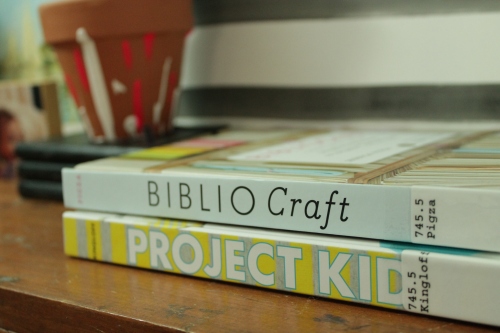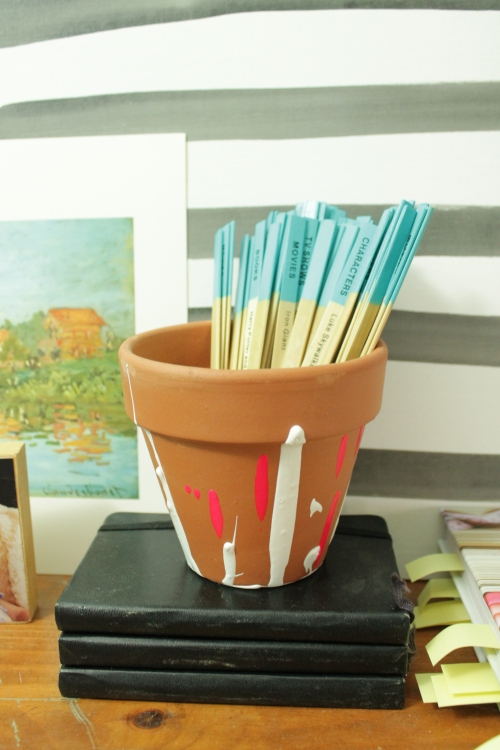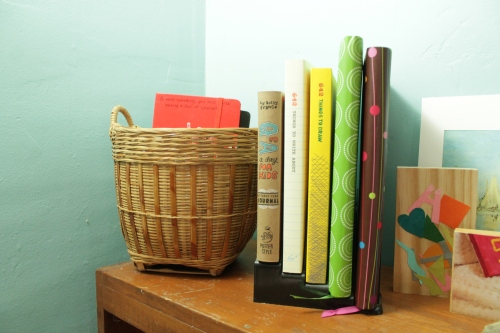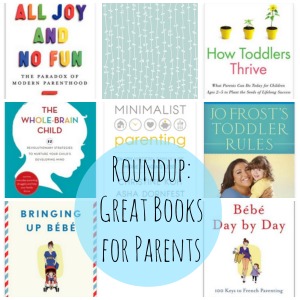I’ve always been mystified by the styled photos of interiors I see in magazines, in blogs, and on Pinterest. “No one actually can live in a house that looks so perfect, right?” I would ask, and of course — the answer is no. They can’t. Images are styled for photographs and then things are moved back to where they were originally, a few dust bunnies reappear, and life goes on.
BUT. I love the look of those styled interiors. We all do, that’s why they exist. So the other night, I set to work styling my bookshelf. I don’t have a mantel, which is often the subject of those perfect images, but I do have a pretty happening bookshelf. It’s a focal point in the living room, and I try to spend a lot of time there. It too often falls victim to clutter — it’s just such a darn convenient place to set random things that need tending, and two weeks later I realize I have to dig it out. My hope is that styling the bookshelf will help prevent that from happening.

When styling interiors, I fully believe that it should remain useful and should include items that are meaningful to you. I’ve seen teen girls’ rooms styled with random books just because the cover’s color added a nice contrast. I’ve seen offices with stuff all over the desk because it looks cool. Are you really going to move your model Eiffel tower, three Reader’s Digest condensed books, and vintage typewriter every time you want to write a blog post?
With that in mind, I styled away. I’ve been inspired lately by the words over at The Nester – it doesn’t have to be perfect to be beautiful. Let’s take a closer look …

I’ve got these two checked out from the library right now, and they are imperfectly marked with yellow sticky notes (you’ll see in a minute). I’m really excited to do some of the projects!

This fancy piece of modern art was made by … me! You’ll never guess how. Done guessing? I used shoe polish to make lines on canvas. This was a project where I didn’t even have to wait for naptime to do it. It took all of two minutes, plus a little bit of drying time. I really like the gradient effect, and I think it makes a great backdrop on my bookshelf.

Something a little more classic now — a print of a Monet painting. This was gifted to us several years ago, before we moved into this house, as a matter of fact. We were always waiting for the right frame or the right place to put it. Well, I found it. I need to learn that art is meant to be enjoyed, not boxed up somewhere waiting for the right time.

You were waiting for those sticky notes, right? Well, there they are. I just made this flowerpot at my library’s Crafternoon program, and I love how it turned out. I threw in a game of charades on sticks, made by Hallmark (and I think not made anymore), and stacked it on top of a few Moleskines (that I actually use!).

No area on display would be complete without a photo of our little darling. I love putting photos on wood blocks for an easy display idea. No frame required, and it adds a nice depth to a display. The rocks were added by the darling herself — she loves collecting rocks when we are out walking, and we needed a place to put them where she could check them out periodically. I think they add a nice touch. The collage on wood was made by Aoife, with a little help from me — I cut out shapes, she brushed on Mod Podge and stuck the shapes where she wanted them. When she was done, I added another coat of Mod Podge and called it good!

And finally, a collection of notebooks and writing inspiration. I’ve been trying to get back into writing poetry and fiction, but it’s been slow going. However, I did write a poem the other day that I felt really great about, so maybe it’s starting to trickle in.
So that’s my new and improved bookshelf. The lower shelves are mostly organized, but little hands love to pull random books out and flip through, so the organization doesn’t always stick.
What do you think of styled interiors? Would you ever use shoe polish in an art project? And how long do you think the cleanliness of this surface will last?





















